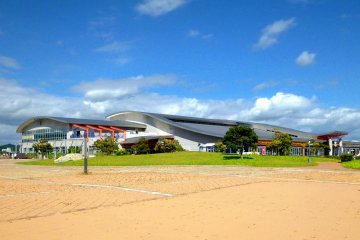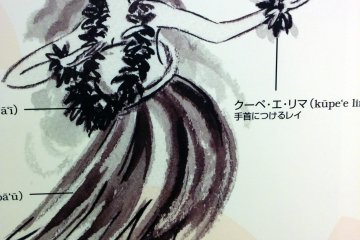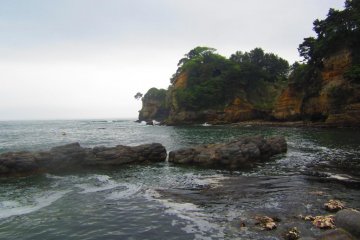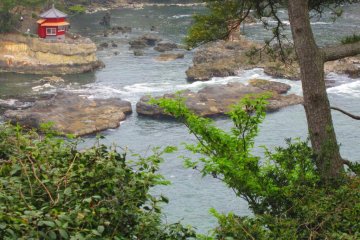At the very northern tip of Ibaraki, only two kilometers from the border with Fukushima, lies a series of rocky inlets facing the Pacific Ocean called Izura. Literally ‘five inlets’, this area is renowned not only for its physical beauty, but also for the rich cultural and artistic history it became the stage for at the turn of the last century. And all of these elements are fused and forged into the little red pagoda bathing in the ocean spray at the foot of a nearby cliff, the famous Rokkakudo.
Rokkakudo, or ‘hexagonal villa’, was the embodiment of the late Okakura Tenshin’s desire to embrace a more holistic form of life in symbiosis with nature, in line with his admiration of the monk lifestyle espoused by many Chinese monks and artists. Tenshin himself is well-known both in Japan and in other parts of the world for the vast influence he had on the arts in Japan and the communication of Japanese culture abroad, and in order to give an idea of the scale of the impact both he and Rokkakudo had on the local community it is necessary and fitting to give him an introduction here as well.
Born in Yokohama in 1863, at the very end of the Edo era of Japanese history, Tenshin, or, as he was known at birth, Okakura Kakuzo, went on to be educated at the University of Tokyo. At a young age he began to hold a deep interest in the arts, specifically in the Japanese style of painting, and after graduating from university (at the age of 17!) he went on to join the Ministry of Education and work to promote the creation of Japanese art schools and art galleries. Though he himself was content to focus on the written word, under his instruction and guidance more than a few famous Japanese painters grew into their own styles and expanded the realm of Japanese painting to include new elements in keeping with the changing times. Tenshin and his students dedicated themselves to re-inventing Japanese painting by the introduction or consideration of themes and techniques found in Western painting, so that Japanese painting would continue to evolve and enjoy a highly-valued place in the world of contemporary art and culture.
Tenshin even went so far as to found the Japanese Art Institute, as a way of spreading his views and educating more students, but prevailing opinion was against them and the Institute soon ran into trouble with funding. Despite this set-back, Tenshin was not without his supporters. Due to his interest in Chinese art and philosophy he travelled to China on 4 different occasions, spent time in Europe, visited India where he met and formed a friendship with Tagore, and through his visits to America became a well-known figure in the Boston arts scene. In fact, he became the art director for the art museum there, choosing the pieces to be included in the collections and influencing artists. In addition, it was during this period that he began writing books in English, such as ‘The Book of Tea’, to explain and share Japanese culture with Western society. Through all this he was widely known for his determination to have a creative part in every aspect of his life, including designing and sewing his own clothing (which he often styled on the clothes worn during the Nara period), inventing a boat that was a cross between a yacht and the typical Japanese fishing boat, and designing and overseeing the building of his dwellings.
So how did a well-travelled literary and artistic giant find himself in the as-yet sparsely inhabited and distant countryside of northern Ibaraki? In fact, he was introduced to the area by one his students, and found the beauty and lifestyle of the Izura area so much to his liking that he resolved to settle there. After building a home right by the edge of the cliff of one of the inlets his students soon followed suit, and a sort of extended artists’ commune developed in the Kita-Ibaraki area. Once the neighborhood was populated with critically acclaimed artists like Yokoyama Taikan and others, Tenshin worked with them to re-build and re-open the Art Institute nearby, where the students would practice their craft side by side, facing the limitless expanse of the Pacific Ocean.
By this point Tenshin was well into middle age, and despite the inconvenience of travel during those days he spent six months of the year in Boston living a busy cultured life; in order to relax he would spend the remaining six months at his home in Izura, mainly fishing and meditating and working with his students.
It was as part of this passion for the Chinese practices of meditation and symbiosis with nature that Rokkakudo was born. He designed and commissioned the construction of a small hut at the foot of the cliff below his home, intending it to resemble the Chinese pagodas seen in ancient scrolls and used by monks and hermits and artists for meditation, artistic production, returning to nature, and as a traditional Japanese tea house. With windows on the three sides facing the Pacific Ocean and a small hexagonal spot in the center for the fire to brew the tea, this tiny room was his favorite place to be, right up until his death at 50 years of age.
Since then Rokkakudo has been used as a symbol of the cultural and artistic heritage of Japan in general and Northern Ibaraki in particular, and had been preserved as a National Cultural Asset under the guidance of Ibaraki University since the early Showa era. That is, until the Great Eastern Japan Earthquake Disaster of last year.
The northern coast of Ibaraki was devastated by the same tsunami as Fukushima and the other afflicted prefectures; in fact, due to the crenulated coastline, the tsunami’s 5-6 meter high waves in other nearby areas topped 10 meters on the Izura cliffs as the water was chanelled into the quickly narrowing high-walled inlets. Within minutes of the water’s impact Rokkakudo was swept cleanly off its foundation and carried back out to sea with the receding waters, and never seen again. It is surmised that the current carried it so far out that it sank past the coast of Japan in deeper waters than it could have been recovered from.
Needless to say, this loss was felt quite keenly by the locals and the artistic community in general, and soon donations and inquiries for Rokkakudo’s reconstruction were pouring in from not only Japan but places as far away as America and Europe. To lead this charge, Professor Miwa of Ibaraki University was named as the director of reconstruction efforts, and in collaboration with Ibaraki Prefecture, the Tenshin Memorial Art Museum, the city of Kita-Ibaraki, and the Japan National Trust, a plan was soon formulated.
However, the very first point of this plan was a somewhat surprising one: though Rokkakudo had been cared for carefully over the years, damage and aging had led to renovations which gradually but concretely changed its structure and appearance over the years, so that it was no longer quite how it had started out. To turn tragedy into opportunity, the reconstruction group decided to take this chance to rebuild Rokkakudo in the spitting image of how it had been during Tenshin’s time, over 100 years earlier. There was just one problem: no one knew exactly what it looked like.
So the reconstruction group put out a call for old photographs of the site, pored copiously over old literary descriptions of it, and consulted specialists with knowledge of the building methods and materials of the period. Through the use of advanced computer technology they were able to colorize old pictures to get an idea of the color scheme, estimate the types of roof tiles and the correct dimensions, and soon they had a blueprint to work with. Now it was just a matter of finding the same materials and fitting everything together.
To this end the highest-level artisans of Japanese building and architecture brought in, and a search for Meiji era materials began. The wood was taken from 150 year old Japanese cedar trees donated by a local; the roof tiles were brought in from a factory in Okayama; and the glass in the windows was imported from a company in England that still made it in the same way as that used in the original Rokkakudo, bubbles and warps and all. In addition, making 4 different surveys of the ocean floor, divers searched for the original pieces of the former Rokkakudo, and found several elements that they were able to include in the reborn Rokkakudo. Altogether, the effort to rebuild Rokkakudo spanned both the dimensions of time and distance, bringing together the knowledge, skills, and emotions of people around the world.
Mr. Miwa himself had just retired from his post as a biology professor at Ibaraki University when the disaster happened and his fate was decided, and speaks glowingly of the experience. ‘To think that after retiring I would be able to do such a fulfilling task is wonderful’, says the self-proclaimed Tenshin and Japanese art aficionado. His enthusiasm and dedication is apparent in every aspect of the reconstruction, and the finished result is a fitting embodiment of his wish that ‘Rokkakudo will become a symbol for the recovery of Japan after this disaster; through this I hope that both locals and those in the other afflicted areas will gain hope and courage to forge ahead in their own reconstruction’.
Finally reopened on April 28th, as a celebration entrance is free for the first month. After over a year Rokkakudo is finally back where it belongs, overlooking Tenshin’s beloved vista and in the form he would remember it in. The tiny red hut is a beauty in and of itself and well worth the trip to Izura.
For those who want to learn more about Tenshin and the cadre of artists he influenced most of his artifacts and information can be found at the 500 meter distant Tenshin Memorial Art Museum, which is a beautifully designed building celebrating its 15th year in operation. Not only does it boast of concerts and local outreach programs with schools, which is how it maintained a local presence in the aftermath of the disaster which saw the roads and parking lot surrounding it completely rendered impassable and requiring 7 months of reconstruction before its re-opening in November of last year, it also hosts exhibits of the art of Tenshin’s students and of Japanese contemporary art from the period of his influence. Despite its setback, the museum was happy to play host to over 17 000 people since its re-opening, and is hoping to attract still more to help recover the revenue lost during its reconstruction. With a beautiful view of the ocean and a lovely café inside, it is a picturesque way to spend the afternoon, and only a short walk from Tenshin’s former home and the indomitable, indelible reborn Rokkakudo.











